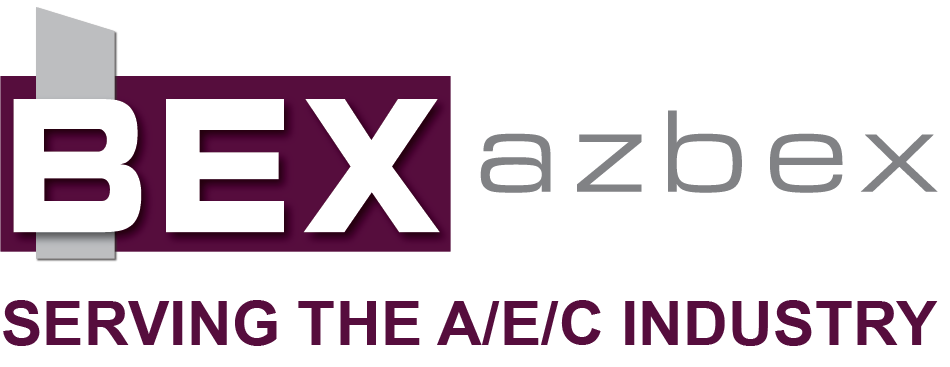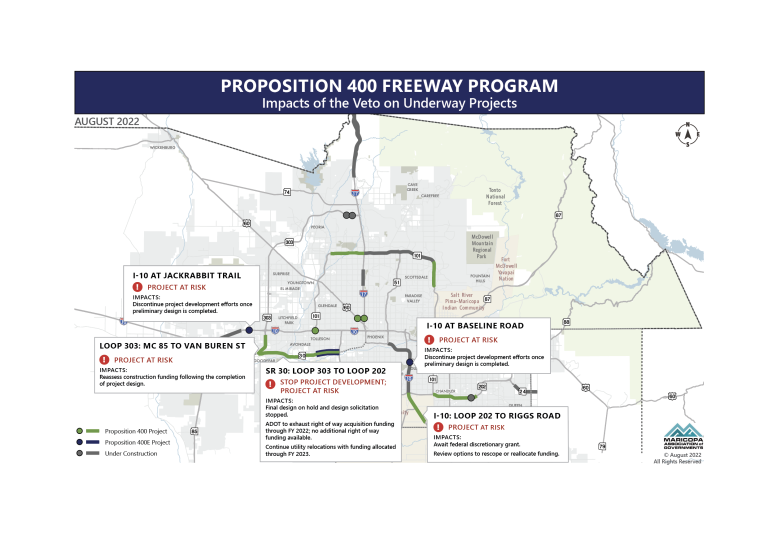By Roland Murphy for AZBEX

Even before Maricopa County voters gave their approval last November for Proposition 479 to continue the half-cent transportation tax previously operated under Proposition 400, the Maricopa Association of Governments had been busy planning and preparing for an expansive set of projects to enhance and expand the County’s vast transportation system.
Over today’s issue and Friday’s we will take a look at some of those projects and plans as presented to MAG committees in meetings last month. Today’s coverage will focus on the Prop 479 Freeway Life Cycle Program, as presented May 21 to the MAG Transportation Policy Committee.
The FLCP represents the financial management tool for the freeway and highway component of the Regional Strategic Transportation Infrastructure Investment Plan, which serves as basis of the Prop 400 extension. A draft Prop 479 FLCP is in development.
MAG is working on sequencing projects under Phase I, since Prop 479 revenue collections will begin on Jan. 1. Some projects are expected to last beyond the 479 life cycle, which closes in Fiscal Year 2046. By that time, the fund balance is expected to have reached projected revenues of $547M. The presentation noted there is little contingency room available if revenues decline or if construction costs escalate.
Draft FLCP Project Changes
Several projects originally planned under Prop 400 have undergone changes in the draft FLCP. These include:
- Combining a Loop 101 at Interstate 10/91st Avenue connector and work at I-10 and 83rd and 91st avenues with a Prop 400 DHOV ramp project at the freeways’ intersection;
- Funding improvements at I-10 at Wild Horse Pass with state appropriation as part of the I-10: Loop 202 to SR 347 project, and
- Combining projects to improve I-10 from the tunnel to the Interstate-17 split, the I-10/Loop 202/State Route 51 Mini-Stack and I-10 Sky Harbor West Airport access into I-10: Tunnel to the I-17 Split and SR 51: Thomas Road to the I-10/Loop 202/State Route 51 Mini-Stack.
Phase I Construction Projects
The presentation then went on to cover details of projects planned in Phase I.
For FY 2026, these projects include:
- A $261M system interchange at Loop 303 and I-17;
- A traffic interchange at I-10 and Jackrabbit Trai for $81M;
- A $71M widening of Loop 303 from Lake Pleasant Parkway to I-17, and
- Widening State Route 24 from Loop 202 to Ironwood Drive for $352M.
Phase I projects in FY 2027 consist of $1.26B to construct the new State Route 30 (Tres Rios) Freeway from Loop 202 to 97th Avenue and a $131M widening of Loop 202 between Loop 101 and I-10.
Notable Development Activities
In the “Notable Development Activities” portion of the presentation, Committee members learned about scoping/environmental work for:
- Loop 303/US 60 (Grand Ave)/Loop 303 System Interchange;
- I-10: Tunnel to the I-17 Split and SR 51: Thomas Road to the I-10/Loop 202/State Route 51 Mini-Stack;
- SR 30 from State Route 85 to Loop 303;
- I-17 widening from the I-10 split to the I-10 stack, and
- Work on U.S. 60: Ellsworth Road to Meridian Road.
They also learned about final design work being conducted for:
- A project at Loop 303 at 155th Avenue;
- Development of SR 30 from Loop 303 to 97th Avenue;
- 1-17 Traffic Interchange West Connection, and
- Loop 202: Loop 101 to I-10.
SR 30 – Tres Rios
One of the most important new developments under Prop 479 is the SR 30 Corridor, also known as the Tres Rios freeway.
When former Gov. Doug Ducey, for reasons still not thoroughly explained, vetoed the original bill that would have sent Prop 479 to voters as an extension of Prop 400 in July 2022, Tres Rios development was one of the most significantly impacted. (AZBEX; Oct. 11, 2022)
As we reported at the time, “SR 30 is a planned approximately 29-mile roadway that will relieve congestion on Interstate 10 in the southwest Valley. The highway’s general path connects Phoenix and Buckeye and lies four miles south of I-10. An earlier 24-mile vision for SR 30 connecting Buckeye and Avondale was included in the Prop 400 renewal passed in 2004. That version was put on hold in 2009 due to revenue decreases in the Great Recession.
“As quoted in the DATABEX detailed project description of the current SR 30 Tres Rios plan: ‘In January 2020, a Location/Design Concept Report (L/DCR) and Final Environmental Assessment (EA) were completed for the SR 30 corridor from the proposed SR 303L to SR 202L. The ultimate corridor improvements include construction of a 10-lane barrier-divided, access-controlled urban freeway that provides four general purpose lanes and a high occupancy vehicle lane (4+1) in each direction and a full system interchange with SR 202L.’”
Because future projects are contingent upon planned funding, in August 2022, the Arizona Department of Transportation canceled a request for qualifications it had issued in May. The design elements in the withdrawn RFQ had allocations of $47M in the FY 2022 Capital Improvement Plan. MAG cautioned at the time the veto would result in project delays of at least two years and add a minimum of $300M to projected project costs.
In May 2022, MAG said, “Funding to construct the SR 30 has been identified in Phase I of the Proposition 400 extension investment plan. As of February 2022, more than half of the needed parcels have been acquired through right-of-way acquisition or are in the process of being acquired. Funding to initiate final design on the portion of SR 30 between 97th Avenue and Loop 202 (South Mountain Freeway) has been programmed in Fiscal Year 2022. Design is expected to take two years to complete.”
After extensive wrangling with the Arizona State Legislature, a bill to send Prop 479 to voters was finally passed and signed, and voters approved the request last November.
SR 30 consists of three main segments: West, Center and East. The Center segment is planned under Prop 400 construction and will run from Loop 202 to Loop 303.
According to the presentation’s update, the $900M Loop 303 extension to connect to SR 30 will advertise for construction this summer.
Right-of-way acquisition and utility relocation work has been underway, and an implementation workshop was held this January to consider potential implementation scenarios for the Center segment.
Final design and right-of-way acquisition are underway for the portion spanning from 97th Avenue to Loop 202. MAG staff has recommended constructing the project from east to west and continuing the ROW acquisition and utility relocation.
Staff has also recommended combining the two planned portions from Avondale Blvd. to 97th Avenue and from Dysart Road to Avondale Blvd. into one project.
Initiation of the final design process will accelerate construction, and $106M has been programmed in FY 2026 to initiate final design on the three remaining segments. MAG will continue to work with ADOT to find ways to accelerate the construction further.
The currently anticipated construction timelines and costs break out as follows:
- 97th Avenue-Loop 202: Starting in FY 2027 and going to 2030; $1.262B;
- Dysart Road-97th Avenue: FY 2029-2031; $634M;
- Estrella Parkway-Dysart Road: FY 2031-2033; $769M, and
- Loop 303-Estrella Parkway: FY 2033-2035; $860M.
Other programmatic elements included for the region and presented in the meeting include funding for freeway sub-programs—including preliminary engineering and advanced ROW acquisition, funding for freeway and highway system capital rehabilitation of pavement, and maintaining the $10M annual allocation for minor improvements.

